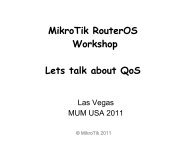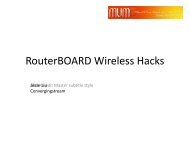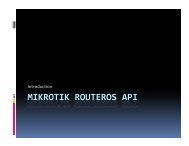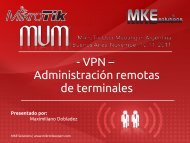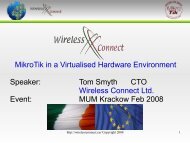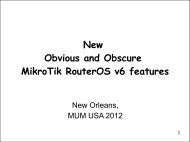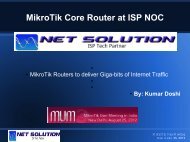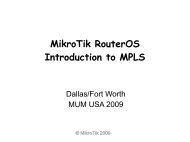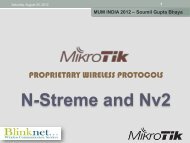MikroTik RouterOS v3 - MUM
MikroTik RouterOS v3 - MUM
MikroTik RouterOS v3 - MUM
Create successful ePaper yourself
Turn your PDF publications into a flip-book with our unique Google optimized e-Paper software.
<strong>MikroTik</strong> <strong>RouterOS</strong> <strong>v3</strong><br />
New<br />
Obvious and Obscure<br />
Mikrotik <strong>RouterOS</strong> <strong>v3</strong>.0 features<br />
© <strong>MikroTik</strong> <strong>RouterOS</strong> 2007
Kernel<br />
<strong>RouterOS</strong> 2.9.43<br />
Linux kernel version 2.4.31<br />
<strong>RouterOS</strong> 3.0beta8<br />
Linux kernel version 2.6.20<br />
For more detailed information see:<br />
http://www.kernel.org/<br />
© <strong>MikroTik</strong> <strong>RouterOS</strong> 2007 2
Hardware Compatibility<br />
SMP (Symmetric Multiprocessing) support<br />
SATA (Serial-ATA) disk support<br />
Maximum RAM support increased from 1GB<br />
to 2GB<br />
Latest interface driver support<br />
Dropped legacy interface support<br />
© <strong>MikroTik</strong> <strong>RouterOS</strong> 2007 3
API Support<br />
An application programming interface (API)<br />
is a source code interface that a computer<br />
system provides in order to support requests<br />
for services to be made of it by a computer<br />
program. (from wikipedia.org)<br />
To enable API, use “/ip services enable api”<br />
Default <strong>RouterOS</strong> API port is 8728 TCP.<br />
For more information see:<br />
http://wiki.mikrotik.com/wiki/API<br />
© <strong>MikroTik</strong> <strong>RouterOS</strong> 2007 4
OpenVPN<br />
An open source virtual private network<br />
Preshared private key, certificate, or<br />
username/password authentication<br />
AES and Blowfish encryption supported<br />
Can be layer-3 (IP packet) or layer-2 (Ethernet<br />
frame) carrier<br />
Run over a single IP port (TCP or UDP)<br />
Default <strong>RouterOS</strong> OpenVPN port is 1194<br />
UDP.<br />
© <strong>MikroTik</strong> <strong>RouterOS</strong> 2007 5
New Web-proxy Implementations<br />
Completely Mikrotik rewritten web-proxy (no<br />
Squid or another pre written source code<br />
used)<br />
Web-proxy package is now fully integrated<br />
into main system package<br />
Web-proxy now is more suitable for Hotspot<br />
use<br />
Web-proxy now works faster and has<br />
optimized memory usage<br />
© <strong>MikroTik</strong> <strong>RouterOS</strong> 2007 6
New OSPF Implementation<br />
Completely <strong>MikroTik</strong> rewritten OSPF (no<br />
Zebra or another pre written source code<br />
used)<br />
Completely new routing-test <strong>v3</strong>.0 package<br />
created (routing-test v2.9 package is now<br />
standard routing <strong>v3</strong>.0 package)<br />
Several previously unfixable bugs fixed<br />
OSPF now has potential for further<br />
improvements ( interface routes, inter-area<br />
filters, pre-interface filters, ...)<br />
© <strong>MikroTik</strong> <strong>RouterOS</strong> 2007 7
New VRRP Implementation<br />
Completely new VRRP implementation, not<br />
compatible with previous versions<br />
Several previously unfixable bugs fixed<br />
Now it is necessary to create VRRP<br />
interfaces instead of just enabling VRRP<br />
feature<br />
VRRP addresses now must be assigned as<br />
regular (/32) IP addresses<br />
© <strong>MikroTik</strong> <strong>RouterOS</strong> 2007 8
Wireless MultiMedia (WMM)<br />
WMM prioritizes wireless traffic according to<br />
4 access categories :1,2 - background 0,3 -<br />
best effort 4,5 - video 6,7 - voice<br />
Different handling of access categories is<br />
applied for transmitted packets - "better"<br />
access category has higher probability of<br />
getting access to medium<br />
Details can be studied in 802.11e and WMM<br />
specification, or, at:<br />
http://wiki.mikrotik.com/wiki/WMM<br />
© <strong>MikroTik</strong> <strong>RouterOS</strong> 2007 9
New Wireless Modes<br />
Station-pseudobridge - learns which IP<br />
address have which MAC address and<br />
translates it.<br />
Station-pseudobridge-clone - uses one<br />
MAC address of the device and clones it<br />
© <strong>MikroTik</strong> <strong>RouterOS</strong> 2007 10
New WDS Mesh Implementation<br />
Two <strong>MikroTik</strong> proprietary WDS modes<br />
added (dynamic-mesh and static-mesh)<br />
to improve WDS-MESH connectivity<br />
between <strong>MikroTik</strong> <strong>RouterOS</strong> devices<br />
© <strong>MikroTik</strong> <strong>RouterOS</strong> 2007 11
New Access List<br />
Entries are ordered now, just like in firewall<br />
Matching by all interfaces “interface=all”<br />
“Time” - works just like in firewall<br />
“Signal-range” - client's signal should be<br />
within this range to match the rule. If the<br />
signal goes outside the range, it is going to<br />
be disconnected.<br />
“Private-pre-shared-key” - each client can<br />
have different key; works only when PSK<br />
method is used<br />
© <strong>MikroTik</strong> <strong>RouterOS</strong> 2007 12
New Access List<br />
© <strong>MikroTik</strong> <strong>RouterOS</strong> 2007 13
New Connect List<br />
“Signal-range” - client connects to an AP<br />
within the specified signal range<br />
If the signal goes out the range client will<br />
disconnect from AP and starts looking for a<br />
new AP.<br />
© <strong>MikroTik</strong> <strong>RouterOS</strong> 2007 14
Other Wireless Features<br />
Full frequency list for Atheros chipset cards<br />
using superchannel frequency mode (2192-<br />
2539 Mhz)<br />
“reset-configuration” command for wireless<br />
interface<br />
Nstreme performance improved for lower<br />
speed boards (RB100 Series)<br />
“Disable-csma” added to disable the<br />
“medium access” protocol, if the Nstreme<br />
polling is enabled<br />
© <strong>MikroTik</strong> <strong>RouterOS</strong> 2007 15
Security profiles RADIUS<br />
“Radius-mac-accounting” - MAC address is<br />
used as user-name<br />
“Radius-eap-accounting” - EAP supplicantidentity<br />
used as user-name<br />
“Radius-mac-format” - which format should<br />
be used to code client's MAC address<br />
“Radius-mac-mode” - where to put the MAC<br />
address “as-username” or “as-usernameand-password”<br />
© <strong>MikroTik</strong> <strong>RouterOS</strong> 2007 16
New Security Profiles<br />
© <strong>MikroTik</strong> <strong>RouterOS</strong> 2007 17
New Security Profiles<br />
Increased speed of the EAP authentication.<br />
Useful to decrease the CPU usage when<br />
tls-mode=no-certificate is used.<br />
Added WPA2 Pairwise Master Key caching<br />
(802.11i optional feature) to increase client<br />
reconnection speed<br />
© <strong>MikroTik</strong> <strong>RouterOS</strong> 2007 18
User Manager<br />
• User Authorization using MSCHAPv1,MSCHAPv2<br />
• User status page<br />
• User sign-up system<br />
• Support for decimal places in credits<br />
• Authorize.net payment gateway support<br />
• Database backup feature<br />
• License changes in <strong>RouterOS</strong> <strong>v3</strong>.0 for active users:<br />
– Level3 – 10 active users<br />
– Level4 – 20 active users<br />
– Level5 – 50 active users<br />
– Level6 – Unlimited active users<br />
© <strong>MikroTik</strong> <strong>RouterOS</strong> 2007 19
The Dude<br />
<strong>RouterOS</strong> package – works as dude server<br />
Speed improvements between server/client<br />
Dude Agents to reach private networks and<br />
offload service monitoring<br />
Reports from any list/table<br />
Support for SNMP <strong>v3</strong><br />
© <strong>MikroTik</strong> <strong>RouterOS</strong> 2007 20
Console: Colors<br />
Console consumes less memory, it has<br />
faster startup and fast export time<br />
References to items, commands, prompts<br />
and exports are coloured<br />
Currently no way to turn colours off, except<br />
running under a dumb terminal<br />
© <strong>MikroTik</strong> <strong>RouterOS</strong> 2007 21
Multi-line Commands<br />
If input line ends with backslash, or has<br />
unclosed braces / brackets /quotes /<br />
parentheses, then the next line is<br />
automatically prompted<br />
Prompt shows "line N of M>" while editing<br />
multi-line command<br />
History walks through multi-line commands<br />
line-by-line<br />
© <strong>MikroTik</strong> <strong>RouterOS</strong> 2007 22
Scripting<br />
Errors now show line position<br />
New console command “:parse” - transforms<br />
text into Mikrotik <strong>RouterOS</strong> command<br />
Non-existing command now generates<br />
runtime error instead of parse-time error<br />
© <strong>MikroTik</strong> <strong>RouterOS</strong> 2007 23
Scripting (part 2)<br />
Updated console command “:typeof”<br />
© <strong>MikroTik</strong> <strong>RouterOS</strong> 2007 24
Scripting (part 3)<br />
Arrays can be written as { item ; item ; item }<br />
inside expressions<br />
New “print” argument “as-value” - allows<br />
returning content of the menu as one array<br />
Each item now has unique, constant ID (.id),<br />
it could be used instead of item numbers<br />
© <strong>MikroTik</strong> <strong>RouterOS</strong> 2007 25
NAT Traversal<br />
NAT Traversal (NAT-T) is a workaround<br />
allowing specific services to establish<br />
connections from masqueraded TCP/IP<br />
networks<br />
Introduced NAT-T for SIP<br />
Introduced NAT-T for IPSec<br />
Rewritten NAT-T for h323<br />
Rewritten NAT-T for PPTP<br />
© <strong>MikroTik</strong> <strong>RouterOS</strong> 2007 26
Interface Bridge Settings<br />
There is a new menu in <strong>RouterOS</strong> <strong>v3</strong>.0<br />
/interface bridge settings<br />
There are two new options<br />
use-ip-firewall (yes|no, default:no)- whether to<br />
pass internal bridge packet through the IP<br />
firewall (conntrack, filters, mangle, nat), or not<br />
use-ip-firewall-for-vlan (yes|no, default:no) – if<br />
“use-ip-firewall=yes” whether to pass bridge<br />
VLAN packet through the IP firewall (conntrack,<br />
filters, mangle, nat), or not<br />
© <strong>MikroTik</strong> <strong>RouterOS</strong> 2007 27
Use-ip-firewall Option<br />
By disabling “use-ip-firewall” option you can<br />
increase bridge performance by:<br />
Up to 40% with random size packets<br />
on the RouterBOARD 200 series<br />
(up to 65% with small and up to 20% with big packets)<br />
Up to 65% with random size packets<br />
on the RouterBOARD 100 series<br />
(up to 80% with small and up to 45% with big packets)<br />
Up to 80% with random size packets<br />
on the RouterBOARD 500 series<br />
(up to 100% with small and up to 65% with big packets)<br />
© <strong>MikroTik</strong> <strong>RouterOS</strong> 2007 28
To be continued...<br />
... it is only beta8 ;)<br />
Questions?<br />
© <strong>MikroTik</strong> <strong>RouterOS</strong> 2007 29




